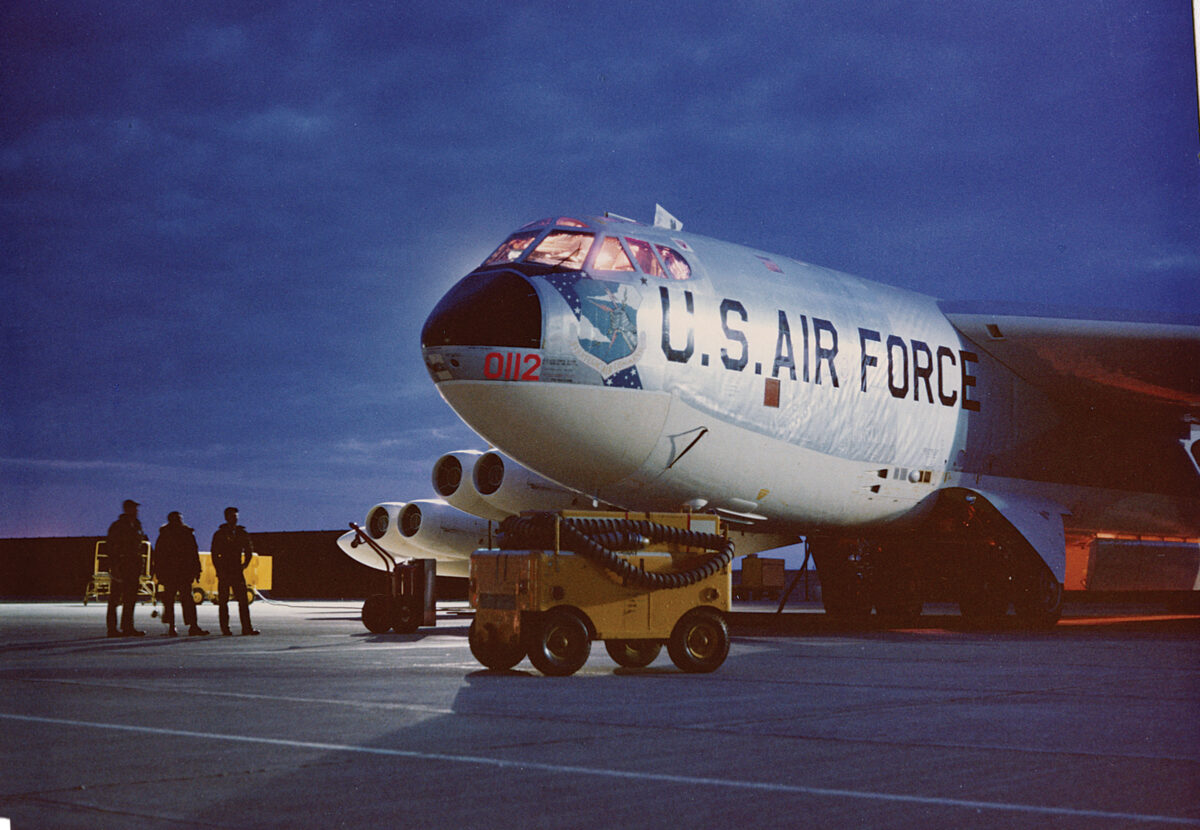During a Cold War airborne alert mission, a combination of mechanical malfunctions and human errors led to the crash of a B-52 with two H-bombs onboard.
Upon hearing the order to bail out, tail gunner Stephen Oarlock reached forward and firmly pulled on the D-handle lanyard that would eject the entire tail gun turret assembly, allowing him simply to step into the sky from the doomed Boeing B-52F Stratofortress. Nothing happened, no matter how hard he pulled on the release. The maintenance crews, preflight crew and Oarlock himself had failed to check for and remove one of the three turret safety pins. Furious communication among the crew resulted in a second order: Come forward now!
Oarlock rotated back his seat, ditched his bulky gear, scrambled through several hatches and began his panicky crawl along the tight starboard bomb bay catwalk. Complying with the two-man rule, the radar navigator, Captain William Hart, stationed himself at the forward hatch to monitor Oarlock’s difficult passage above the cargo: two thermonuclear bombs. Thus ensued Strategic Air Command’s second “Broken Arrow” incident of 1961, this time over the picturesque Sutter Buttes of California’s Central Valley.
As the Cold War warmed in the late 1950s, General Thomas S. Power, commander of the U.S. Air Force Strategic Air Command (SAC), implemented an airborne alert program designed to ensure almost immediate U.S. retaliation against its enemies, replacing the prior “launch on warning” policy. SAC began rotating bombers and aerial refueling tankers through continuous flights near the Soviet borders 24 hours per day, seven days a week. Although President Dwight D. Eisenhower did not permit onboard nuclear weapons until October 1959, under the Head Start I and II and Steel Trap I and II testing programs SAC had amassed more than 6,000 B-52 sorties by 1961.
To carry out this new mission, SAC had activated 14 dispersed strategic wings by 1958. Almost all of them fielded a squadron of 15 B-52 bombers supported by 10 to 15 KC-135A Stratotankers, with at least half the bombers on a 15-minute alert status. In April 1958 SAC assigned to California’s Mather Air Force Base the 4134th Strategic Wing, composed of the 72nd Bombardment Squadron and the 904th Aerial Refueling Squadron. General Power briefed Congress on his successful efforts early in 1959, and in January 1961 SAC officially announced that B-52s were conducting these operations, but described them as only airborne training.
These early airborne alert missions revealed a multitude of problems. As the sortie rate increased, trained mechanics and vital spare parts for the B-52s and K-135s were in short supply. Ground crews cannibalized aircraft for parts and struggled to maintain overworked jet engines and fatigued aircraft electrical systems that experienced excessive power cycling. General Power soon returned to Congress to request more funding.
March 13, 1961, dawned bright and clear at Mather AFB east of Sacramento as Major Raymond Clay’s refreshed crew prepared to take their B-52F aloft once more to Alaska under the Operation Coverall airborne alert program. Around 9:30 a.m. Major Clay, the command pilot, attended the preflight briefing with his crew. First Lieutenant Robert Bigham was his copilot and Captain Joseph Ethier, the third pilot, joined them on the flight deck as a student. Electronics weapons officer (EWO) Tech. Sgt. Alexander Baltikauskas sat behind them. On the lower deck—the “Black Hole”—were radar navigator Hart and master navigator Major Morris Levy. Spare radar navigator Captain Robert Dobson joined them in a jump seat. Tail gunner Tech. Sgt. Oarlock sat apart from the rest of the crew, facing rearward in the pressurized tail compartment to operate the quad .50-caliber machine guns. Mather Control designated Clay’s bomber “Doe 11” and a sister B-52F flying in their two-plane cell “Doe 13.”
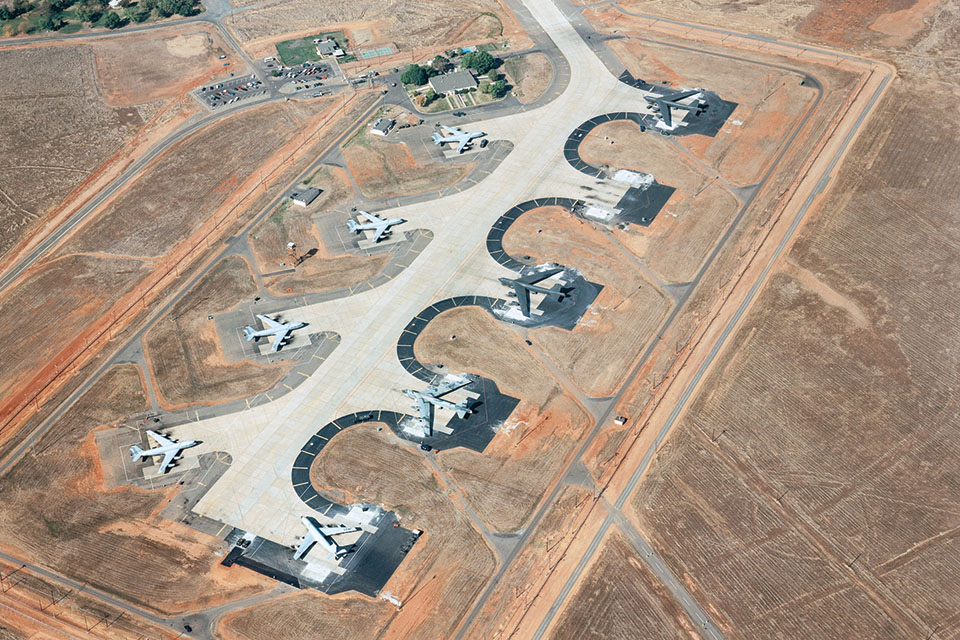
Weaponeers from Mather’s Weapons Storage Area carted out two Mark 39 Mod 2 thermonuclear weapons (H-bombs) to the Christmas tree–shaped alert ramp. A thick steel outer casing accounted for much of the mass of the 6,600-pound weapons. The ground crew clipped each 11.4-foot-long bomb into a suspension pallet before winching them into the bomb bay. The radar navigator could set the weapon for either a parachute-retarded air burst, ground-contact burst or a parachute-retarded laydown.
Each H-bomb yielded 3.8 megatons of explosive energy, enough to obliterate a large city and its suburbs. Unlike earlier models containing cores that ground or flight crews could remove, the nuclear primary stage (the fission core) consisted of a sealed hollow grapefruit-sized plutonium and oralloy (highly enriched uranium, or HEU) composite core, which no ordnance crew could remove without disassembling the weapon. High explosives (HE) surrounded the core and served to compress it to criticality. Each bomb’s secondary (the fusion stage) consisted of a solid lithium-deuteride cylinder surrounding an HEU “spark plug” rod.
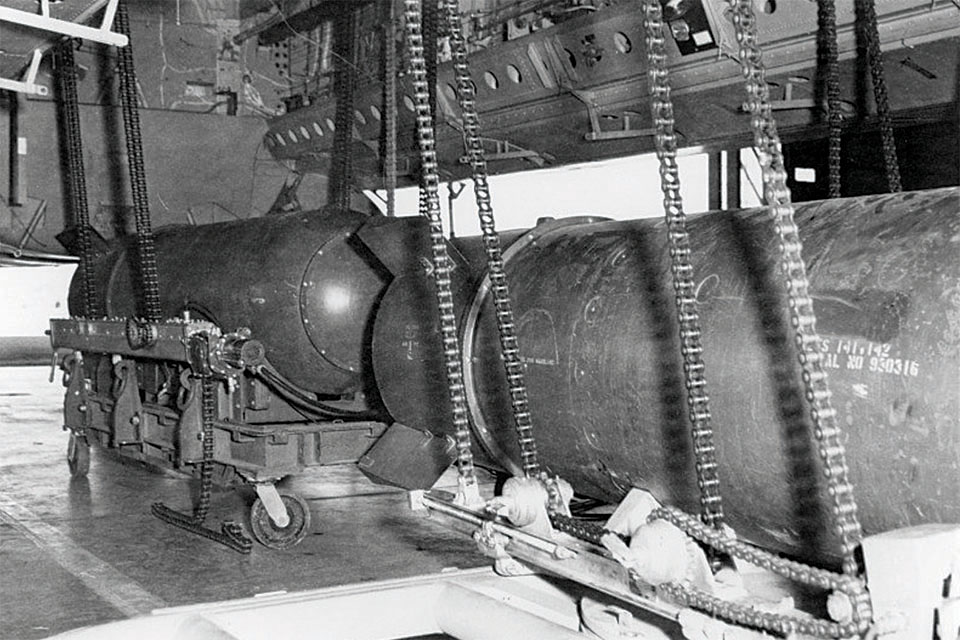
Doe 11 and Doe 13 took off at 11:25 local time, with plans for extensive over-water travel and two refuelings during their 24-hour mission. Troubles began early. Twenty minutes out, Doe 11’s forward cockpit crew began to experience the first of several maintenance-related problems that plagued the sortie. While they circled over Fortuna, Calif., for almost an hour, Clay reported that they could not control the heat blowing from the vents below the instrument panel.
In the B-52F, the final compressor stages of the engines forced 750-degree bleed air into a ram manifold that cooled it to 475 degrees. Four-inch pipes routed this pressurized hot air to air conditioning packs, which were also fed cool ram air from wing ducts. Conditioned air cooled electronics and also served to cool, heat, ventilate and pressurize the crew cabins. Bleed air also powered 10 hydraulic system packs.
While the rest of Doe 11’s cabin remained cool, all efforts to block the blistering heat flowing into the cockpit failed due to a malfunctioning relay that locked an air valve in the full hot position. The crew’s options were limited. To cool the cockpit, they had to shut down the packs, bring in ram air and depressurize the cabin, requiring them to don oxygen masks. Shutting down those packs, however, also would cut off cool air to the electronics.
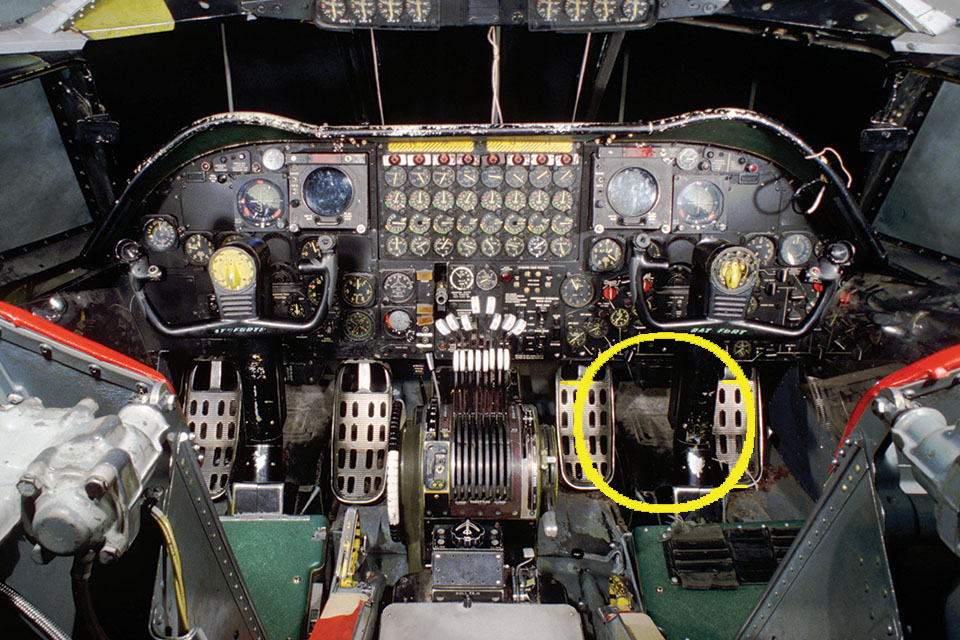
Despite these difficulties, a mission-focused Major Clay turned his bomber northwest out of California and over the Pacific Ocean. The crew endured the heat for the next 22 hours, rotating all three pilots and the EWO through cockpit shifts and shuttering the packs to cool down only prior to and during aerial refueling, a maneuver that required all pilots to be in the cockpit fully suited-up and breathing bottled oxygen.
Six and a half hours after takeoff, with one refueling complete and 30 minutes into their second loop near the Aleutian Islands, the crew discussed their problems with Mather Control. Clay reported that “the stick is so hot that you can hardly hold your hands on it with gloves on.” Mather Control was firm and maintained one consistent message—to keep Operation Coverall on schedule: “Stay out there as long as you can, fly the route as far as you can. Fly at altitude on oxygen as long as you can, but first let the tankers know tonight what your problem is, and if it continues, then fly as long as you can and then come home.”
Additional problems cropped up throughout the night. The copilot’s rate-of-climb indicator malfunctioned and the no. 3 engine lost 30 percent of its power, which required hours of de-icing to improve. Seven hours out, during the second refueling, the forward fuel tank gauge stopped working and Hart experienced severe pain in his left knee from depressurization (i.e., the bends), which diminished once the packs fired up again.
Eleven hours into the flight Mather Control made their point again: “Understand you will complete your mission. Is that affirmative?”
“We are going to try,” Clay responded. “We are going to try.”
The mission reached a critical point 14 hours after takeoff, about 30 minutes after the fully refueled Doe 11 and 13 started their third loop, when the outside panel of Clay’s window shattered. Soon the unbearable 125- to 160-degree heat in the cockpit cracked the glass cases on both turn-and-slip indicators. Clay depressurized again at 33,500 feet, but not for long as Bigham began to suffer abdominal cramping from trapped gas and Hart re-experienced the bends in his knee. Within 20 minutes, Clay decided to descend to 12,000 feet for the rest of the mission and let Doe 13 proceed ahead of them.
About an hour and a half after the window shattered, Bigham, who was monitoring fuel consumption, took a scheduled rest on the upper deck bunk. Oxygen use and extreme heat had dehydrated the crewmen and they depleted their drinking water only 15 hours after takeoff, reporting to Mather, “Sure would like to have a drink if you can send it up.” By 17 hours after takeoff, the crew was spent and alerted Mather that they would soon turn back to California. Their return was fraught with errors and more dysfunctional equipment, with the bomber burning fuel at an accelerated rate due to its lower altitude.
A little more than 20 hours after takeoff, the gauge for the no. 1 main fuel tank stuck at 10,200 pounds, a condition Bigham didn’t notice until after he returned to the cockpit an hour and a half later. Also, since Levy had not been resetting their current position with the best known data, the crew miscalculated their fuel burn rate.
After 21 hours, Doe 11 advised Mather: “We would like to have a tanker up here and get a little fuel. We now figure we will be over the field at 14,000 pounds. That is a little light.” Mather responded, “We will not launch [a tanker] unless you go below 10,000 pounds.” Not long after Bigham discovered the hung-up gauge he advised Mather: “We have number one main tank now that is stuck at 10,200 pounds, and we are not sure just how much fuel it does have in it now….I think it would be a good idea to get that tanker airborne.”
Mather radioed: “We have a tanker airborne [but the 904th did not launch tanker Razor 93 for another 20 minutes]….You pick him up on a track between Red Bluff and back in this direction. You might keep in mind, if things get a little close up there, head into Beale [AFB, east of Yuba City].” Clay ultimately never chose that option.
After making long detours around turbulent weather fronts, which further extended their flight, Doe 11 coasted back over Fortuna a little more than 22 hours after takeoff at 9:35 a.m. local time. At 9:51 Clay and crew passed over Red Bluff, found no tanker and turned south toward Mather at 12,000 feet and 322 mph. When they spotted Razor 93, they asked it to reduce speed so they could catch up. But less than 2½ miles from the tanker, Doe 11 exhausted its fuel.
All eight of the B-52’s engines began to flame out at about 10:03 over the eastern flank of Sutter Buttes. Clay immediately rolled into a westerly 30-degree bank to avoid the populated Yuba City area and headed toward open farmland. Upon completing the turn, he ordered the crew to bail out. At an altitude of about 6,500 feet, Levy fired his ejection seat downward first from his navigator position. Dobson and Ethier followed by jumping through the now open hatch below the navigator station. Baltikauskas then fired his ejection seat on the top deck. After his highly motivated crawl from the rear of the bomber, Oarlock finally arrived in the forward crew cabin, donned a parachute and jumped though the open navigator hatch. Bigham then ejected upward, followed by Hart below.
Having confirmed that all of the crew had bailed out, Clay attempted to trim his now dead bomber for the best possible glide path and ejected with the ground only 4,000 feet below him. Levy and Bigham suffered leg fractures upon impact with the muddy earth, their parachutes dragging them 30 to 40 feet before they could collapse them. The official SAC accident report later stated that the two men sustained their injuries because they had failed to release their survival kits prior to ground impact. Dobson, Hart and Clay suffered only minor scrapes upon landing and Baltikauskas, Ethier and Oarlock were uninjured. Less than a half-hour after bailing out, Clay reported to the wing commander by telephone from the Sanborn Ranch near Meridian.
The now unmanned bomber began a lazy left downward spiral over the farmlands southwest of Yuba City. Doe 11 slowed to 230 mph as it completed a full 360-degree circle in a several mile wide arc. In a shallow 15-degree bank with its nose down five degrees, the bomber impacted the asphalt Moroni Road at a 45-degree angle a little before 10:15. The northern embankment of the road stripped off the 3,000-gallon left wing drop tank as the aircraft began to cartwheel across John Hopkins’ 120-acre ranch. Although never electrically armed by the crew, the two Mark 39s did not fare well, as the impact broke them loose from their pallets and crushed their steel casings, sending fissile, high-explosive and other components downrange along with scattered aircraft debris.
Within 30 minutes of Clay’s bailout order, the local SAC liaison officer notified the Joint Nuclear Accident Coordinating Center, “We had another North Carolina type incident,” i.e., a Broken Arrow like the one on January 24, 1961, near Goldsboro, N.C. Specialists from Mather, Beale, McClellen and Kirtland AFBs; Los Alamos Scientific Laboratory; Sandia Corporation; and the Atomic Energy Commission (AEC) immediately converged on the crash site. Less than two hours later, the explosive ordnance disposal (EOD) team from Beale confirmed that the two hydrogen bombs were severely damaged but their HE had not detonated and no radioactive materials appeared to have been released.
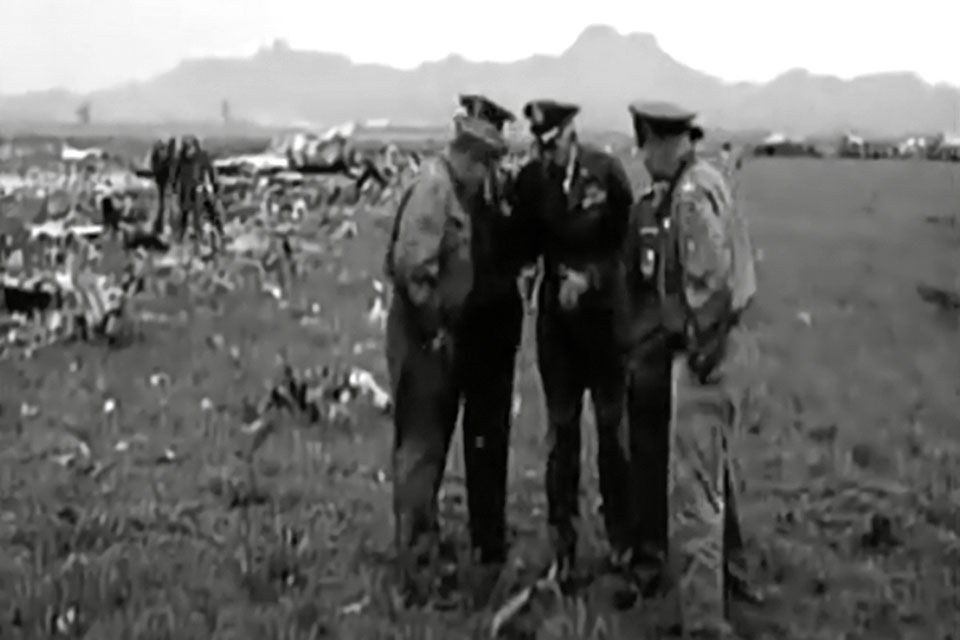
Doe 11 was scattered across 20 acres of Hopkins’ fallow rice field. The two hydrogen bombs were about 40 yards from each other. One had fragmented into two parts, and its shattered chunks of HE and still intact plutonium and HEU core were scattered within 10 to 20 yards. To minimize transportation risks, the EOD team gathered and burned the HE fragments and detonators in a small pit on the ranch, but trucked the nuclear components to Beale for further scrutiny and eventual return to the AEC. Cleanup crews took several weeks to remove almost 165,000 pounds of aircraft debris.
SAC’s accident report identified the primary cause of the incident as supervisory errors at Mather Control and its failure to launch a fuel tanker in time to save Doe 11. Clay had expected to rendezvous with the tanker in the Red Bluff area, which would have allowed him to take on more fuel before his engines flamed out. However, there was no doubt that onboard attempts to monitor fuel consumption were inadequate in light of failing and stuck gauges and the increased rate of fuel consumption after the bomber descended to 12,000 feet. The accident report clearly documented repeated encouragement by Mather Control to continue the Coverall flight in spite of these significant equipment malfunctions and the crew’s inability even to keep the cockpit fully manned during most of the mission.
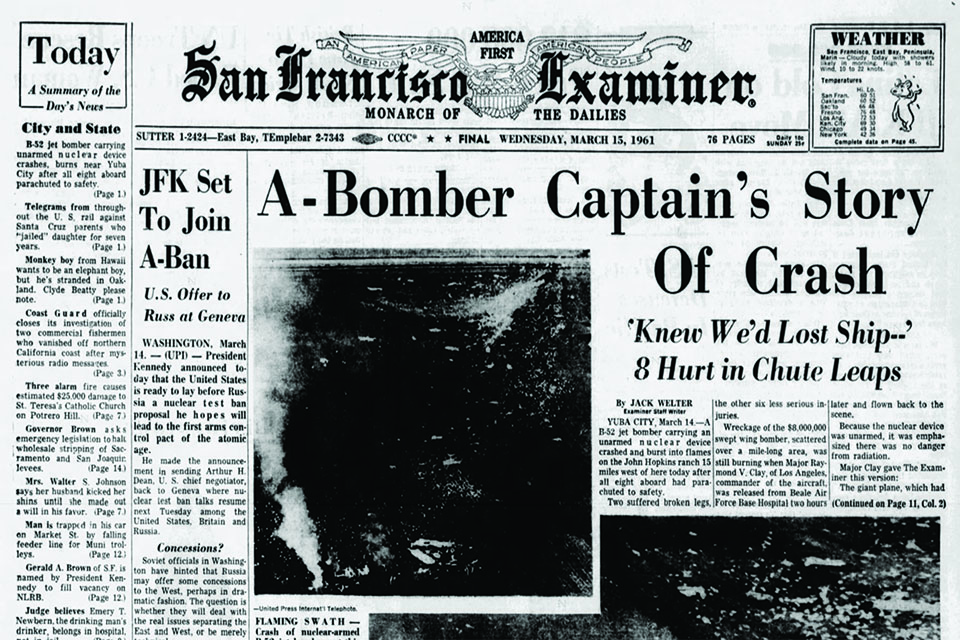
Historical SAC documents suggest that stimulants were available to flight crews, and wing commanders may have encouraged their use for these 24-hour airborne alert missions. In his book Jet Age Man, retired USAF Lt. Col. Earl J. McGill gained some notoriety by stating incorrectly that the accident board found the primary cause of the incident was pilot error induced by dextroamphetamine (he called them “Go Pills”) that impaired Clay’s judgment. McGill further asserted that due to the Doe 11 crash SAC made the use of amphetamines a court-martial offense.
The accident report made no mention of the stimulant, however, and McGill seemed to confuse the details of the Doe 11 accident with the earlier Goldsboro Broken Arrow. He further reminisced that before he and his B-52 crew headed out to the flight line, they dipped into a jar full of Go Pills for their flights where “those little guys made us the sharpest pilots in the universe.” In the end, there is little evidence to suggest that stimulants were a factor in this accident. What was obvious to the Air Force investigators was that, beyond fatigue from sleep deprivation, the crew was under extreme physical stress from high heat, dehydration and hypoxia, all contributing factors to the accident.
Nevertheless, General Power’s strong desire to deploy the early airborne alert program had driven the SAC chain of command hard, to the point where wing commanders faced intense pressure to roll the dice and fly missions even with multiple hardware failures. As the aircraft commander, it was Major Clay’s prerogative to declare an emergency and abort the mission. But he too likely surmised from his own leadership chain that failure was not an acceptable option. Even after Clay described several serious problems during the flight, Mather Control’s clear direction was to “fly as long as you can” and “complete your mission.”
Timothy Karpin and James Maroncelli are the authors of The Traveler’s Guide to Nuclear Weapons: A Journey Through America’s Cold War Battlefields. They last wrote for Aviation History in the July 2019 issue about a Broken Arrow incident in 1958 near Savannah, Ga. (see “Amazing Story of the Lost H-Bomb”). Further reading: Broken Arrow: The Declassified History of U.S. Nuclear Weapons Accidents, by Michael H. Maggelet and James C. Oskins.
This feature appeared in the September 2021 issue of Aviation History. Don’t miss an issue subscribe!

